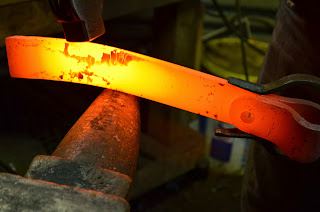Even the dentist would ask the blacksmith to make special hammers and tooth pulling devices like this dental pelican that Zach made for a historical reenactment museum some years back. The blacksmith forged axe heads to fell lumber, he made nails for boards, blades and knives for cutting and was responsible for giving the strength of steel to many items needed on the homestead.
The Farrier
Often, when Zach tells people he is a blacksmith they assume that he shoe's horses. Historically, the blacksmith was also the farrier of the town. But as automobiles replaced horses, the art of blacksmithing became a separate skill from the synonymous farrier.
A farrier must have an understanding of the blacksmith trade in order to shape and mold horse shoes and to make nails other tools like tongs to hold the shoes and shape them in the forge. But in addition, a farrier must be trained in hoof care, like shaping the hoof, fitting shoes for a horse's particular needs and being able to recognize disease or injury.
Often, in newly settled towns where there was no doctors or veterinarian available, the blacksmith would have the most experience in animal anatomy. Many times he was called upon for all sort of animal ailments like treating injuries and assisting with difficult births. And even one step further, he was sometimes called to assist in delivering human babies.
The Term Blacksmith refers to a craftsman who works with metal in a forge. Historically the blacksmith worked with wrought iron, but today, more commonly works with "mild" steel or carbon steel. The prefix "Black" refers to the dark scale that flakes on the surface of the steel when it is heated. The work of the blacksmith is usually a more rudemental art. Shaping larger pieces like tools or horseshoes as opposed to fine work like jewelry.
Zach is mostly an artist blacksmith, but not everything he makes is for beauty. He forged a disk a few months ago to fix our dishwasher, tractor parts, car parts, rake teeth for our hay rake, and tools...lots and lots of tools. Not only tools like the fro shown here, (used to split wood) but tools for his own blacksmith craft.
 A blacksmith's starter kit requires a forge, an anvil of sorts, and a hammer. There are many variations available to use, but after these three elements are established, the blacksmith must learn to make his own tools. Mostly because the tools that he uses are non-existant and very specialized. You can't go to Sears and pick up the things you need to start forging.
A blacksmith's starter kit requires a forge, an anvil of sorts, and a hammer. There are many variations available to use, but after these three elements are established, the blacksmith must learn to make his own tools. Mostly because the tools that he uses are non-existant and very specialized. You can't go to Sears and pick up the things you need to start forging.One of the first tools a blacksmith must make is a set of tongs so that he can remove hot objects from the forge and hold them steady on the anvil while he hammers. More tongs are made as projects require specific holdings. Jigs are created to shape metal in a repeated or awkward manner and as the blacksmith's craft develops, a collection of handmade tools acquire over the years.
A Whitesmith is someone who might work with a more malleable metal like tin or pewter. It can also refer to a blacksmith who works his products to finer finish through detailed filling, polishing and buffing, thus leaving the metal in a shiny or "white" finish.




.jpg)
No comments:
Post a Comment